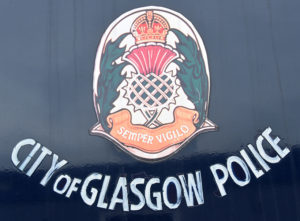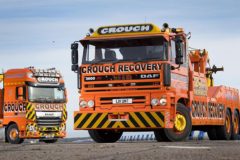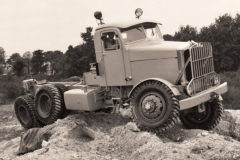Albion FT21 ‘Black Maria’
Posted by Chris Graham on 31st January 2020
Bob Weir samples one of the most celebrated Albion FT21 ‘Black Marias’ in Scotland, and really senses it’s murky, working history

During its heyday, the sight of JGD 426 – a fine example of an Albion FT21 – would have struck fear in many a villain’s heart
There can’t be many commercial vehicles that can match the sullen splendor of Albion’s FT21 ‘Black Maria’. The lorry is a piece of Scottish history, and has been a regular on the Scottish vintage vehicle circuit for over two decades. Now it’s to be sold at Morris Leslie Classic Auctions of Errol, by auction manager, Keith Murray. “We’re very lucky to be handling the sale of this famous vehicle,” Keith explained. “We’ve auctioned several Albion lorries over the years, and JGD 426 has an excellent pedigree. We’re expecting a lot of interest.”
Popular auctions
The Morris Leslie Group started life in 1974, and is still in private ownership. Over the past four decades, the group has diversified into plant hire, modular buildings, auctions and property. Of interest to commercial vehicle fans is the quarterly classic vehicle auction, which usually attracts some rare and important commercials.
The group’s headquarters is at the old Errol airfield, between Perth and Dundee. The airfield originally opened in January 1943, and was managed by the RAF. The facility was a bit hush-hush at the time, and was used as a special conversion unit for Soviet aircrew taking delivery of British aircraft. The RAF pulled out in 1948, and the airfield slowly went into decline. Morris Leslie bought the surviving buildings, and the site is now home to the classic vehicle auction.
“We’ve been holding regular auctions now for many years,” Keith explained. “Our twice-weekly modern auctions take place every Tuesday and Thursday evenings, and our commercial plant sales are also held at regular intervals. We also hold light commercial sales, and our classic vehicle auctions happen once a quarter. These have proved very popular, and we get buyers from all over the UK. The auction also attracts some well-known vehicles, like JGD 426.”

JGD 426 has been in private hands for most of its life, but still looks the part
Cops and robbers have been around since the beginning of time, and transporting prisoners in custody has been a headache for authorities for generations. Some criminals’ desperate attempts to escape the long arm of the law while in transit to and from jail, have filled the history books, television and movie screens. Over the years, police forces have had to come up with more ingenious ways to keep their charges under lock and key, and this especially applies in the era of motorised transport.
First prison vans
The earliest recorded prison van in the UK appeared in 1858, and was horse-drawn; a far cry from today’s modern juggernauts. But, once the police became fully motorised (official records show that the boys in blue’s first official vehicle was a Wolseley 7.5bhp), the Black Maria became an important and necessary tool in the police’s armoury.
By the turn of the 20th century, many of our major cities had earned a reputation for violence and skullduggery, and Glasgow was no exception. The infamous razor gangs of the Depression years have been well documented and, by the 1950s, the police had their hands full keeping a lid on crime.
Serious efforts were made to improve prison security, and convicts found it increasingly hard to escape once they’d been locked up. A trip in a prison van offered a fleeting chance to abscond, and regular attempts were made to hijack vehicles carrying villains to and from the courts. So, it was no surprise when Glasgow’s authorities turned to one of their own for a purpose-built Black Maria.

The Black Maria’s interior in its original layout
Albion Motors was based in the Glasgow district of Scotstoun, to the west of the city centre. The firm began by making cars, before switching to commercial vehicles. By the time the FT series of lorries was introduced after the Second World War, the company had earned itself a solid reputation. The Black Maria was just the latest in a long line of successful designs, and JGD 426 was one of a matching pair bought by City of Glasgow Police. Registered in Glasgow on May 18th, 1951, the lorry was well-equipped to join the ongoing fight against crime.
Final journeys
Despite the fond memories the Albion logo ‘Sure as Sunrise’ usually inspires, there was nothing romantic about Glasgow’s Black Maria. Some of Scotland’s most dangerous murderers spent their final few moments sitting on the polished wooden benches, as they were transported to the gallows. In JGD 426’s case, this included the famous 1950s serial killer, Peter Manuel.
Manuel had been born in America, before his family returned to live in Scotland. He was convicted of murdering a total of seven women across the county of Lanarkshire, between January 1956 and his arrest in January 1958. He’s also thought to have murdered two other people, but this was never proven. Prior to his arrest, the media nicknamed the unidentified killer ‘the Beast of Birkenshaw’.
Manuel had a track record for violence against women, as he’d already served nine years in prison for a string of sexual assaults. In 1955, he successfully conducted his own defense against a rape charge. Manuel also possessed a twisted sense of humour and, during the lengthy investigations for the seven murders, he anonymously sent Christmas and birthday cards to the detective leading the enquiry, ‘to keep him on his toes’.
During the trial, he sacked his lawyers and, for the second time, conducted his own defense. This time, though, he couldn’t fool the jury, and was found guilty and sentenced to death. As he went to the gallows, his last words were allegedly ‘turn up the radio and I will go quietly’. Manuel was hanged at Glasgow’s Barlinnie Prison by prison hangman, Harry Allen, on July 11th, 1958, and he was the third to last prisoner to be executed in Scotland.

On June 30th, 1800, the authorities of Glasgow successfully petitioned the British Government to pass the Glasgow Police Act, establishing the City of Glasgow Police. It served Glasgow from 1800 to 1975, when it was amalgamated into Strathclyde Police. It’s sometimes described as the first modern-style, municipal police force
Film appearances
The story has recently been the subject of a three-part crime drama, called In Plain Sight. JGD 426 also made an appearance in the 2008 film Stone of Destiny; a true story about Scottish nationalism.
The Albion FT21 was a three-ton model introduced in 1949. The type had originally been launched in 1947 as the FT5, to bridge the gap between the AZ9 and the FT3. The model number was changed after it was decided to fit front and rear axles from the new Chieftain range.
The FT5/21 models were closely based on the earlier FT3, and were equipped with either the EN271 four-cylinder, 2.8-litre, or the EN272 four-cylinder, 3.04-litre petrol engines, driven through a four-speed, crash gearbox. Lighter tyres were also specified, and Albion also made a short wheelbase model. Unlike the oil-engined variants, they didn’t get the facelifted front with recessed headlamps and flared dash. As they were the only models in Albion’s three-ton category, they were kept in production after the Leyland takeover.
Glasgow police eventually decided to dispose of JGD 426 (chassis no: 71569B) in 1962. The bus was sold at auction and bought by a local fruit and veg merchant. Mobile shops were very popular during the 1960s, and the new owner is believed to have used the vehicle to sell his wares around some of Glasgow’s large housing estates.
Previous restorations
The logbook also shows that one of the previous owners was a John Robertson, from Chapelton near Strathavan, who acquired the vehicle on Feb 10th, 1988. It’s believed that he restored it to its original state, minus, of course, the interior prison cell. The Albion then passed to well-known enthusiast, the late Frank McDougall, from Ayrshire. But, because Albion spares from this era were hard to find, Mr McDougall decided to replace the Albion engine with a modern, Perkins 4236 four-cylinder, 3.5-litre diesel unit. He also fitted a new, fully-synchronised gearbox, as the original unit was badly worn.

The engine compartment, with its replacement Perkins 4236. The diesel has certainly improved the van’s performance
Mr McDougall was a member of the Albion Club, based at the company’s spiritual home, in Biggar, South Lanarkshire. JGD 426 was a regular entrant at the Biggar Albion Foundation Limited rally held each August and, with the new engine fitted, often took part in road runs.
There are only believed to be a small number of FT21s still in existence, and not all the survivors are thought to be in a roadworthy condition. A few are located as far away as Australia and New Zealand, as a lot of Albion lorries were exported during the post-war years. JGD 426 is believed to be the only surviving Albion Black Maria, although you never know what surprises could be lurking in somebody’s barn!
Despite its spotless interior, and the smell of polished wood, climbing into the back of the Black Maria is certainly an eerie experience. It’s all too easy to imagine the days when the UK still had capital punishment, and the vehicle played host to some of Glasgow’s most notorious criminals. One can still sense an air of desperation and impending doom lurking in the confined space. Glasgow Police had a tough reputation, and the back of the van must have been the scene of some lively confrontations. Handcuffs were even attached to the bench slats to keep the prisoners under control.
Practical use
In recent years, the back of the Albion was converted into a makeshift camper. Some carpet, seats and cupboards were installed, although these would have been alien creature comforts to some of the Black Maria’s original occupants! Although not to everyone’s taste, these alterations at least allowed the van to fulfill a useful function. According to Keith, no permanent changes were made to the vehicle’s interior, and the fixtures and fittings can easily and quickly be removed.
I was fortunate to be shown round JGD 426 by Frank McDougall back in 2004, and couldn’t resist Keith’s offer of a quick spin around Errol airfield’s old perimeter. Much to its credit, the Albion started first time. Although the original engine was replaced many years ago, the Perkins diesel is still up to the mark. The performance was impressive, as Keith put the Black Maria through its paces. There was also enough atmosphere in the cab to imagine what it must have been like being a prison officer back in the 1950s.

The cab offers plenty of space, with excellent visibility
“The new owner will be faced with some interesting choices,” said Keith. “Should he or she, keep the lorry in its current condition, or return the Albion to its original state.” Until the hammer comes down at the auction, the jury is out.
‘Black Maria’ origin
The origin of the name ‘Black Maria’, as applied to closed police vans with separate, locked cubicles, is said to have originated in Boston, Massachusetts, during the 1830s. Legend has it that a formidable boarding house madam by the name of Maria Lee, did the local constabulary a good turn by escorting rowdy drunks at gunpoint to the nearest jail. She was so successful in handling tough characters that, when police wagons came into general use in Boston, the police remembered her help and immortalised her name by calling the prison carts, Black Marias.
The term Black Maria was also used in print publications of the period, and is still used today to describe prison vans in the UK and Australia. The term was also used by the popular music band The Clash, back in the 1980s, in the song Guns of Brixton. The description is familiar in Norway where the same vans are called ‘Maja’ or ‘Svarte-Maja’, meaning Black Maria. The Black Maria is also called ‘Mother’s Heart’, meaning there is always room for one more.

Despite the fond memories the Albion logo ‘Sure as Sunrise’ usually inspires, there was nothing romantic about Glasgow’s Black Maria
Specifications
Make: Albion FT21N (71569B)
Year: 1951
Registration: JGD 426
Original engine: Albion EN271B
Cylinders: 4
Gearbox: 4-speed
Rear axle: Albion
Further information: Morris Leslie Vehicle Auctions, Errol Airfield, Errol, Perth PH2 7TB Tel: 01821 642574. To visit the company’s website, click here
To subscribe to Heritage Commercials, click here





